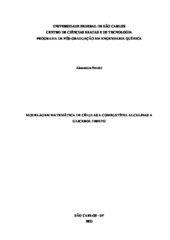Modelagem matemática de células a combustível alcalinas a glicerol direto
Abstract
In the environmental and energy context, fuel cells are promising devices for the conversion of clean energy, with hydrogen being the most used fuel. However, its storage and distribution impose some difficulties, in addition to having high reactivity. Based on this, the use of liquid fuels, such as light polyols, is a viable and promising alternative, mainly due to their low toxicity and the possibility of oxidation at low temperatures. The solid alkaline membrane fuel cell (SAMFC - Solid Alkaline Membrane Fuel Cell) is an advantageous option in the use of these alcohols, as they exhibit higher reaction rates in alkaline medium. In this context, glycerol demonstrates potential attractiveness, as its theoretical energy density is similar to that of other alcohols that are already well established in fuel cells (methanol and ethanol), it is highly available on the market, and its oxidation produces compounds with high added value, in addition to energy. Despite this, direct glycerol fuel cells (DGFC - Direct Glycerol Fuel Cell) still need to improve their electrical performance, which is affected by the catalytic activity of the catalysts and also by the fuel cell's operational parameters. When considering an alkaline DGFC with a polymeric membrane, it is a SAMFC fed with glycerol. In this context, mathematical modeling and computer simulation are tools of great importance for the development of fuel cells. Thus, the objective of this master's work is to carry out the kinetic modeling of glycerol oxidation in a DGFC, considering two different approaches: 1) realistic phenomenological models for the partial oxidation of glycerol in Pt/C, considering its adsorbed intermediates; 2) model of artificial neural networks (ANN – Artificial Neural Networks) for oxidation mainly in PtAg/C and PtAg/MnOx/C. The models were fitted to experimental data already available for validation and determination of their parameters, both using Matlab software. The adjustments of the parameters of the phenomenological model were obtained by minimizing the sum of squared errors (SSE – Sum of Squared Errors) between the real and experimental current density of the fuel cell. For this, the fmincon function of the Matlab software was used. Also, the estimation of the standard deviation of the parameters was performed, in addition to the parametric sensitivity. As for the ANNs, the algorithms available in the artificial neural networks toolbox, from the same software (Matlab) were used. Results for the phenomenological models developed showed excellent fits for the polarization curve, with a RMSE (Root Mean Squared Error) value of the order of 0.352 to 0.404 mA/cm², in addition to coverage fractions consistent with the literature for the adsorbed species. The kinetic parameters with the greatest influence on the response of the models were those associated with the consumption of glyceric acid and the formation of tartronic acid, and with the dissociative adsorption of water and the formation of PtOads active sites. The parametric sensitivity made with the most significant kinetic constants shows a relevant change in the polarization curve. It was also observed the effect of changing the value of the most significant kinetic constants in the distribution of coverage fractions of all adsorbed intermediates (to maintain the fit of the model to the polarization curve). Such an evaluation brings great insight into the influence of model parameters on the degree of coverage of the catalyst (and vice versa). Regarding the neural models, excellent prediction fits were obtained for all of them, with RMSE values in the order of 0.008 to 0.014 mA/cm², denoting the possibility of representing the functional interdependence between input variables and the density cell current for cases where it would be too complex to do so via mechanistic modeling (i.e., for PtAg/C and PtAg/MnOx/C oxidation).
Collections
The following license files are associated with this item:

